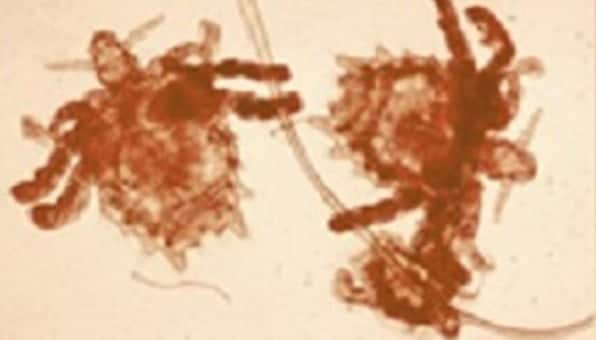Key points
- Pubic lice, also known as "crab" lice, are parasitic insects found in the pubic or genital area.
- They are usually spread by sexual contact.
- Symptoms include itching or visible lice in the genital area.
- Both prescription and over-the-counter treatments can treat pubic lice.

Overview
Pubic lice are parasitic insects that feed on human blood. They are short and crab-like and look very different from head and body lice. Pubic lice typically attach to hair in the pubic area. Adult pubic lice are 1.1–1.8 mm in length (size of a pencil tip).
Either over-the-counter or prescription medications can treat pubic lice infestations. Infestation or infested person means that a person has lice.
Symptoms
Signs and symptoms of pubic lice include:
- Itching in the genital area
- Visible nits (lice eggs)
- Lice crawling or attached to pubic hair
- Lice in other hairy areas (eyelashes, eyebrows, beard, mustache, armpits, chest, back)
Pubic lice do not transmit disease. However, you could get sores and a bacterial infection from intense scratching.
Who is at risk
Anyone can get pubic lice. Pubic lice usually spread through sexual contact and are most common in adults.
How it spreads
You usually get pubic lice from intimate, person-to-person contact, usually sexual contact. Occasionally pubic lice can spread by clothing, bedding, or (very rarely) using a toilet seat that was just used by a person infested with public lice.
Adult pubic lice are found only on humans and require blood to survive. They will die within 24 – 48 hours without a blood meal. Female adult pubic lice lay about 30 eggs during their 3 – 4-week life span. Eggs hatch after about a week. Nymphs (newly hatched lice) mature into adults over 6 to 9 days.
Animals do not get or spread pubic lice.
Pubic lice found on the head or eyelashes of children may be an indication of sexual exposure or abuse.
Prevention
The following are steps that can help prevent and control the spread of pubic ("crab") lice:
- Examine yourself and seek treatment if you experience any of the symptoms of pubic lice or a sexual partner has recently had pubic lice.
- All sexual contacts should be examined. All those who are infested should be treated.
- Avoid all sexual contact with others until treatment is successful.
- Machine wash and dry worn clothing and used bedding by the infested person in the hot water (at least 130°F) laundry cycle and the high heat drying cycle. Dry clean clothing and items that are not washable OR seal them in a plastic bag and store them for two weeks.
- Do not share clothing, bedding, or towels used by a person infested with pubic lice.
- Do not use fumigant sprays or fogs; they are not necessary to control pubic ("crab") lice. They can be toxic if inhaled or absorbed through the skin.
Diagnosis
Pubic lice infestation is diagnosed by finding a "crab" louse or nits on hair in the pubic region or, less commonly, elsewhere on the body. These areas include the eyebrows, eyelashes, beard, mustache, armpit, groin, torso, scalp, or anus. Pubic lice are short and crab-like; they appear very different from head and body lice (I.e., they are broader and flatter than other lice). Although pubic lice and nits can be large enough to see with the naked eye, a magnifying lens may help to see them.
Lice found on the head generally are head lice, not pubic lice.
If you are unsure about infestation or if treatment is not successful, see a healthcare provider for a diagnosis. Consider getting tested for other sexually transmitted diseases (STDs).
Treatment and recovery
You can treat pubic lice with a lice-killing lotion containing 1% permethrin or a mousse containing pyrethrins and piperonyl butoxide.
These products are available over-the-counter without a prescription at a local drug store or pharmacy. These medications are safe and effective when used exactly according to the instructions in the package or on the label.
